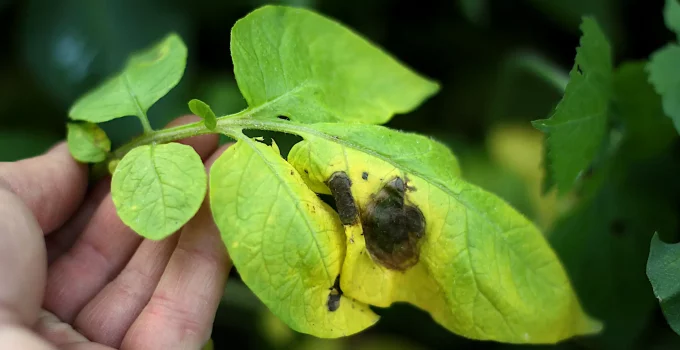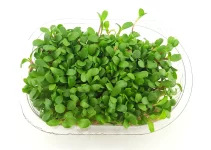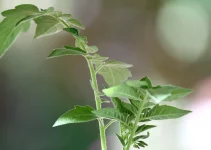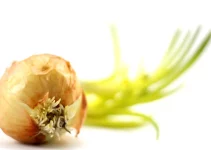There are a few situations that might lead to potato leaves turning yellow: harvest time is near, not enough sun, too much water, magnesium deficiency, nitrogen deficiency, too much nitrogen, potassium deficiency, verticillium wilt, fusarium wilt, potato cyst nematodes, and potato/tomato psyllid.
Let’s talk about each of these causes individually and see how they might lead to the appearance of yellow potato leaves. Obviously, we should discuss what we can do to grow healthy potato plants that give the best yield.
You should keep in mind that, even if potatoes are pretty easy to grow, these plants also require lots of nutrients throughout the growing season. We need to regularly fertilize our plants if we want to grow plenty of healthy, delicious tubers.
If you want to know more about growing these tubers, check out my guide on how to plant sprouted potatoes.
Table of Contents
Why Are Potato Leaves Turning Yellow?
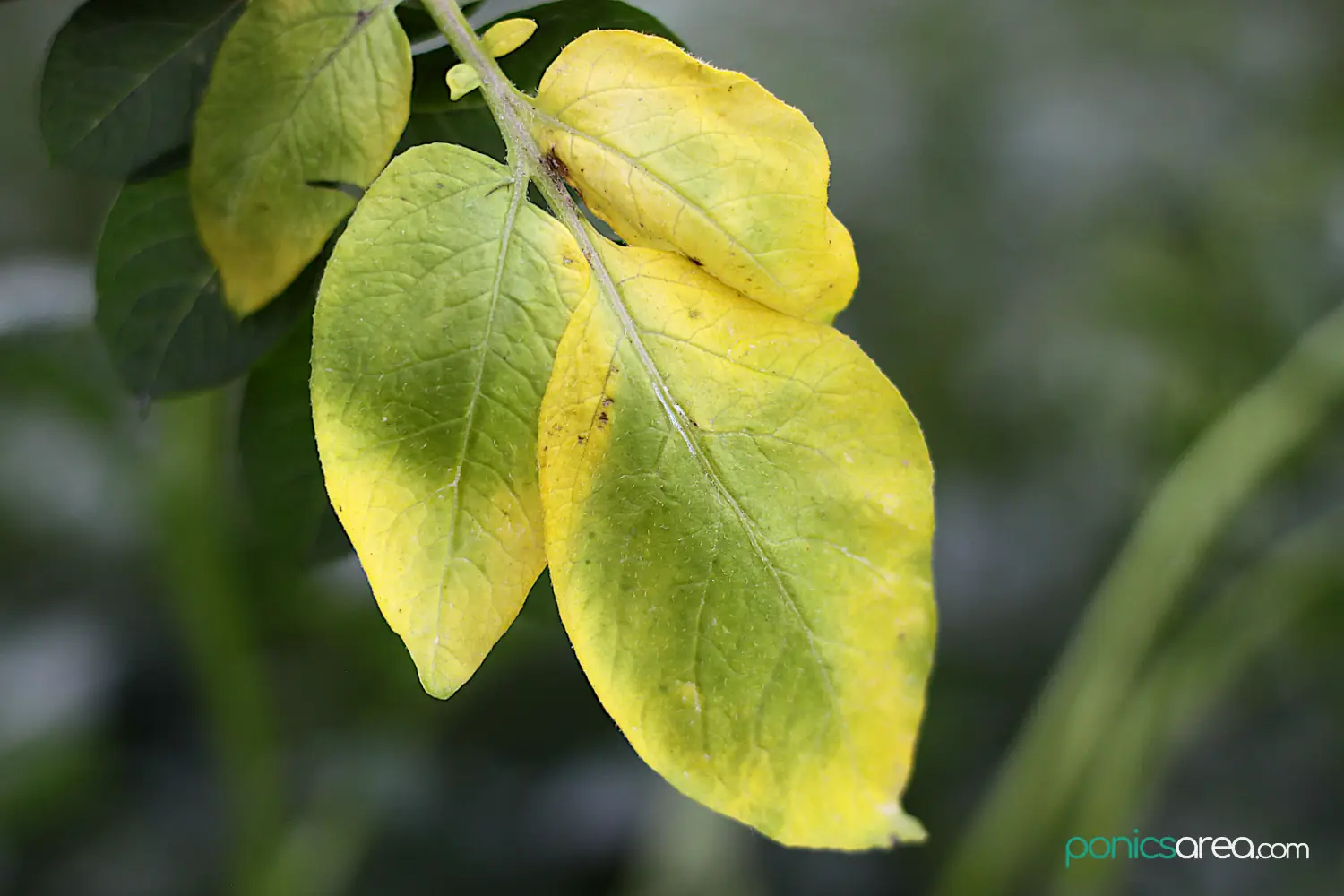
When investigating what might cause yellow potato leaves, it’s kind of like a guessing game. Since there are a bunch of causes for potato leaves turning yellow that means that you’ll have to eliminate the causes one by one. It’s not fun.
1. Ready for harvest
Let’s make one thing clear: if the leaves are turning yellow towards the end of the growing season, that’s an indication that you can harvest the tubers.
It’s natural for leaves to turn yellow at the end of the growing season.
The problem is when the leaves turn a different color other than green when the tubers are not yet ready for harvest.
2. Not enough sun
Let’s start with something easy. A cause that’s not a disease or a nutrient deficiency.
Maybe you’re very lucky and not enough light is reaching the plant, which leads to potato leaves turning yellow.
It’s a pretty obvious cause for yellow leaves on plants: if there’s not enough light, the rate of photosynthesis is limited.
If the lack of sunlight is very serious and prolonged, the tubers will grow smaller and less plentiful. That’s something to monitor, especially by those growing in containers.
Potatoes need at least 6 hours of sunlight per day. If you’re growing indoors, you might need grow lights.
3. Too much water
Let’s get on with our less serious causes for potato leaves turning yellow.
Too much water or too little water can make leaves turn yellow.
If there has been a period of excess rainfall, that might be the cause for your troubles. If the plants are waterlogged by rainfall for a period greater than 24-36 hours then the tubers are asphyxiated.
This can seriously affect the tubers by making them prone to attacks from microorganisms in the soil.
Floods are a serious problem for potatoes. Tubers are living organisms. When they’re waterlogged and the tubers can’t obtain enough oxygen, lenticels enlarge so that they can get more oxygen.
Eventually, enlarged lenticels will present like small white popcorn on the tuber surface.
Floods are unfortunate phenomena and we can’t do much about them.
However, if you’re growing in containers, make sure to avoid overwatering or underwatering.
The soil should be kept moist but never soggy. When the top 1-2 inches of the soil feel dry (stick a finger in the soil), you can water until a bit escapes from the drainage holes.
4. Magnesium deficiency
Magnesium is crucial for photosynthesis – it forms part of the chlorophyll molecule and is involved in protein production.
If the plant doesn’t absorb the needed magnesium from the soil then the leaf tissue between the veins on the leaf start to turn yellow.
It starts with the bottom leaves first. These will be first to show interveinal, pale-green to yellow choloris.
The leaves will eventually turn brown and become necrotic.
You can basically tell that the cause might be magnesium deficiency if it starts first on the tissue between the veins of the lower leaves, which leads to brown spots on the same leaves.
The margins often remain green. That’s another clue to see if it’s a case of magnesium deficiency.
Solution
Obviously, the solution is to deliver magnesium to our plants. Magnesium is also known as epsom salt so it’s not hard to find.
One way to attempt to remedy the magnesium deficiency is to spray the leaves with a magnesium leaf spray.
In order to make your own magnesium foliar spray you need to dissolve 2 tablespoons of Epsom salt in a gallon of water.
If you’re already regularly feeding your plants with a fertilizer that contains magnesium, nitrogen, potash, phosphates, then I don’t think that the cause is magnesium deficiency.
In the autumn or winter, in order to fortify the soil for the next crops, you can apply Epsom salts or calcium-magnesium carbonate to the soil.
Where to Buy?
Check Price and User Reviews Here
5. Nitrogen deficiency
Let’s continue on our road of discussing mineral deficiencies that can lead to potato leaves turning yellow.
Nitrogen is part of the chlorophyll molecule, just as it’s the case with magnesium. It’s what gives the plants their green color and creates food for the plant through photosynthesis.
Lack of nitrogen contributes to chlorosis of the plant (general yellowing).
It’s not very hard to spot a nitrogen deficiency. The symptoms are:
- plant exhibits stunted growth
- there are only a few thin stems
- leaves are yellow-green
- leaves are small and drop prematurely
If tubers grow, they will be in very low quantities. Nitrogen deficiency leads to low, poor yield.
Solution
Liquid plant foods are fast acting. If you notice a general yellowing of your plant with thin stems, apply liquid food so that it can act quickly.
All purpose liquid plant food, general-purpose grow formulas will work nicely for providing nutrients to plants.
Tomato fertilizers are also some of the best for growing healthy potatoes.
After that, continue to feed the plant according to the instructions that come with the plant food.
When you’re growing vegetables, you can also add compost on top of soil every month.
A thing you can do in spring is to apply a balanced feed to the soil to replace nitrogen in the soil.
In the fall, you can work 1-2 inches of compost into the top 3-5 inches of soil.
Moreover, put a handful of compost in each hole when you’re planting.
Where to Buy?
Check Price and User Reviews Here
6. Too much nitrogen
The reverse can also happen. You might over-fertilize your plants. It’s rare but it can happen.
The leaves turn yellow while the veins remain green.
If you’re using liquid plant foods or granular fertilizers, make sure to follow instructions. I will say that it’s very rare for over-fertilization to be the cause.
7. Potassium deficiency
We couldn’t leave potassium deficiency from causes that might contribute to potato leaves turning yellow.
It’s important to understand the symptoms that set these various mineral deficiencies apart.
In the case of a lack of potassium, the leaves turn yellow and then brown at the tips, margins, and between veins.
Older leaves are the first affected. They can entirely discolor, crinkle, curl, and drop.
Once again, the solution is using liquid plant food. Get a fertilizer low in nitrogen but high in potassium and phosphorus.
You can also add a layer of compost to the soil and do that once a month.
Where to Buy?
Check Price and User Reviews Here
8. Verticillium wilt
Verticillium wilt is a fungal disease that lives in the soil.
Symptoms:
- first, we get wilt symptoms
- it starts at the bottom and moves upward to younger leaves
- one side of the leaf turns yellow and wilts
- later, the entire leaf turns yellow
- yellowing is followed by browning and necrosis
- brown discoloration of the vascular area of the stems
It becomes evident when lower leaves turn yellow and wither. If you’re observing that, you need to consider the possibility of verticillium wilt.
The disease is favored by stress induced by heat, drought, nutrient deficiencies and insect damage.
Due to verticillium wilt, crops don’t give the usual yield, yield losses occur.
In order to prevent this fungal disease, you should practice crop rotation. It’s a preventive method that should be used by everyone.
Also, plant certified seed tubers. Select varieties that are resistant to wilt.
9. Fusarium wilt
It’s another fungus that can affect our crops.
The symptoms for fusarium wilt in potatoes are:
- yellowing of the leaves
- wilting, rolling, curling of the leaves
- sometimes only one side of the plant is affected
The symptoms resemble those of verticillium wilt. The difference is that the tissue between the leaf veins turns yellow and then brown.
Frankly, these two are hard to tell apart.
10. Potato cyst nematodes
These are microscopic worm-like pests. If you’re looking at pictures of potato cyst nematodes, you might lose your appetite for the whole day. And then you’ll pray that this isn’t what ‘s happening to your plants.
The worm-like pests feed on the roots of potato, tomato, eggplant and other plants from the Solanaceae family. You can read more about these pests here.
The signs to look for are:
- stunted growth
- weak looking plants
- upper leaves are pale green, going towards yellow
- the leaves wilt during daylight hours
- lower leaves fall off
- tubers are tiny, marble sized
There is no solution for these things. The tubers and the plants need to be totally destroyed.
Avoid the infected land for a few years.
As a prevention method, I would recommend crop rotation. Also, look for a resistant variety that’s good for your area.
11. Potato/tomato psyllid
According to Colorado State University, potato/tomato psyllid is the most damaging insect to potatoes and tomatoes in Colorado.
These insects called psyllid nymphs resemble small cicadas and are less than 1 inch long, about the size of an aphid, must be taken seriously.
When these insects feed, they introduce toxic saliva into the leaves, which leads to the disease psyllid yellows.
The psyllid nymphs will feed on the underside of the leaves. That’s where you have to check out for them. These insects also tend to concentrate on the lower more shaded parts of the plant.
The easiest way to recognize if your plants have been attacked by these insects is to look for leaves that are covered by wax-covered pellets, known as psyllid sugar.
These insects have clear wings and dark gray bodies with white markings on the first and last abdominal segments. When disturbed the adult insect can jump.
The symptoms are:
- marked yellowing of the leaves on white and russet varieties
- pale pinks and purples in red and blue varieties
- upright appearance to the leaves
- areas of the stem on potatoes often will swell
- sometimes small tubers will form on the above ground parts of the plant
- severe cases resulting in early death of the plant
Tuber production can be seriously affected.
Solution
Treat infested potato plants with imidacloprid or spinosad. Check on the packaging of the insecticide for instructions on how to apply it and how often you should use it.
Spinosad is the most commonly available insecticide. It can be quite effective in controlling potato/tomato psyllid.
12. Potato blight
One of the most common diseases that can affect these plants is potato blight. Late blight was responsible for the Irish potato famine. You can understand how serious it can be since it can decimate entire crops.
If we have a wet August, blight can destroy our entire harvest. A wet summer is dangerous both for tomatoes and potatoes.
It attacks the tubers or tomato fruits causing rotting.
This is a disease caused by a fungus-like organism that will spread through the foliage and tuber in warm wet weather.
Even if the late blight doesn’t lead to yellow leaves exactly, I just wanted to let you know about this disease. To inform you about how you can prevent it.
You should actually watch out for brown patches on the leaves.
You should also check out underneath the leaves to spot for white mold.
Solution
The solution is in prevention. If you want to avoid potato blight, you need to prevent it because that’s the only course of action.
Spray for blight control in July. Even when you have spotted the brown spots on the leaves, you should still spray to prevent the spread of the disease.
Also, cut the leaves but don’t use them for compost and don’t burn them. Just put them in the garbage in a sealed bag.
Blight affected potatoes will have a reddish/brown coloring just below the skin. You can’t store them because they will rot.
To sum up
As I’ve mentioned in my introduction, potato plants require lots of nutrients throughout the growing season.
Thus, we need to fertilize, making our best to keep the plant healthy to grow quality tubers.
We also need to implement a system of crop rotations to ensure a healthy soil.
Also, plant certified seed tubers. They are not guaranteed to be disease free but they’re certainly better.
And pray that no floods, wet (August) summers or nasty diseases/insects affect our plants. That’s what we can mainly do about all these potential causes for potato leaves turning yellow.

